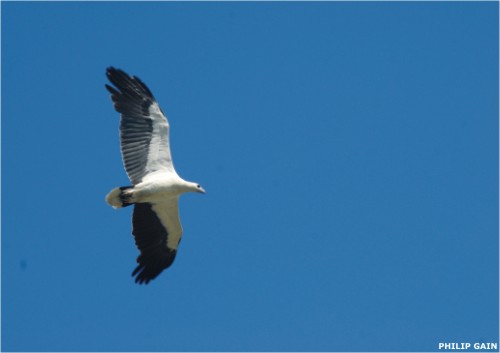
Inside
|
Sidr and the Sundarbans Philip Gain makes a painful visit to find the World Heritage Site devastated, though hope still flickers
A month and half ago before the cyclone, I was in a group of seven photographers that spent ten days in the eastern part of the Sundarbans. We floated through the Sundarbans for all those days and nights. Our everyday trip in a small boat through the intricate web of nature, sometimes threatening to human life, was a real thrill. With lower salinity level compared to the western part, this part with high vegetation is full of wildlife and other life forms. Roaring tigers, pugmarks in several places, flocks of deer and monkeys, coloured birds and snakes in hundreds, wild pigs, meadows, and columns of lush green vegetation -- all remain sharp in my memory. My memory was shaken when I went back to the cyclone-devastated eastern part of the Sundarbans on November 23. We had already known from newspaper reports quoting the sources in the Forest Department that "one-fourth" of the 6,017 sq. km. Sundarbans has been badly hit by winds of 250 km per hour and a 5-metre tidal surge. Our first stop to take a close look over the fate of a forest office is Harintana in Chandpai Range. We are appalled to see the impact of Sidr. The forest office, including the jetty, has been completely demolished. Bits and pieces of wood are scattered all over the office premises. A trawler has been thrown up on the ground from the canal by the tidal surge. The trees have been twisted, broken, and the green leaves all gone. We find a few Forest Department (FD) employees of the station on their patrol boat. "The winds, rain, and waves lasted for hours. We boarded our patrol boat and took refuge in a canal. We survived 10-12 feet high waves," says FD boatman Md. Idris Alam. The FD staff of this office had been living on the patrol boat since the cyclone day. They don't go on the ground for fear of the unknown, including tiger attack. As we move further down, we are deeply shocked at the devastation caused to the mangroves, a natural shield for human habitation against winds and tidal surges. Had the forest not been there, the cyclone could have been deadly for the nearby towns -- Khulna, Mongla, and Bagerhat. The forests took the brunt of the winds and tidal surges, and saved these towns from severe devastation. Experts believe that the forest will gradually recover. But if the cyclone had hit these towns, the economic fallout would have been much more calamitous. We take a look at the forest office at Tiar Char only to find the office destroyed and deserted. What remains of the office are the cracked walls. The roofs, windows, and doors have blown away. The trees are broken and twisted. Everything looks burned down. We don't have the courage to land. We head for Kokilmoni with the same devastation on the both sides of the river. As we come near to the forest office at Kokilmoni, we see just one deer and one wild pig. We spent a night and a morning at Kokilmoni a month and half ago during our 10 day trip to the Sundarbans. Kokilmoni office premises is known for deer. We saw scores of deer in flocks then. In the morning as we took to a narrow canal in our small boat, we had a terrifying experience. We came across a roaring tiger. We did not see the tiger although it was some 50 feet away from us in the bush. The tiger was shaking the jungle every time it roared. It was mating season for the tigers and the roaring one was probably inviting a partner. As we had been hoping that the tiger would cross the canal, we saw a vine snake on mangrove shrub basking in the sunny morning. It was terrific to be so deep into nature The cyclone has undoubtedly wiped out large quantities of deer, snakes, insects, wild pigs, and many other life forms. The damage to Kokilmoni forest office has been massive. There is no sign of the jetty. The roofs, windows, and doors of the office building have been blown away. Finding the office premises uninhabitable, the FD employees have deserted it. We find some ten fishermen's boat. Some of them were at Kokilmoni during the nightmare. Three boats and six nets have been washed away from here. However, no one died. The fishermen took refuge in the canal and were lucky enough to have survived the winds and tidal surge by holding on to the trees. Our launch anchors at Kokilmoni to wait for the ebbing tide. Our next destination is Dublar Char, which actually encompasses 11 pancake shaped low-lying islands. Next morning as we approach Dublar Char we are dismayed to see broken, twisted, and uprooted trees. We see no tree standing with green leaves on the banks of the channels. We see a few sea gulls and eagles, but no other birds. The cyclone has rendered the forest barren and silent. We see the forest office at Office Killa in Dublar Char from a distance. The tin-shed house on concrete structure is still standing. As we go closer, we see that all the doors and windows and the tin-shed roof of the office building have been thoroughly torn apart. The walls are fractured. A wooden house on its right has been washed away. There is a cyclone shelter at Office Killa. Md. Alauddin, acting in-charge of the Dublar Char forest office, still in trepidation, narrates: "Some 700 people took refuge in the L-shaped cyclone shelter. The winds began to flow at about 5:00 pm. The strongest ones hit at about 9:30 pm. The big wave that lasted for hardly 15 minutes almost flooded the first floor of the shelter. Had the water stayed for another ten minutes, the cyclone shelter would have collapsed. It was shaking as water hit and receded." We find the base pillars of the cyclone shelter cracked. A mosque on the side of the cyclone shelter has been completely destroyed and washed away. Md. Osman, a fish worker took refuge in the mosque. "As the water began to flow into the mosque, I managed to climb on the nearby cyclone shelter. My companion, who also tried to reach the cyclone shelter, was washed away by the strong wave. We later found him dead," says Osman.
Md. Abul Quashem, a caretaker of the Cyclone Preparedness Program of Bangladesh Red Crescent Society in Dublar Char, tells his experience of the cyclone. "We have our wireless facility in Office Killa cyclone shelter. We blew siren and invited people to come to safety. The fishermen did not want to come leaving behind their boats, nets, and dried fish. Many took refuge in the canals with their boat. Most of them have perished," says Abul Quashem. The fish workers who did not take refuge at the cyclone shelter became the worst victims. "In Dublar Char, we have known that 201 people have died," reports Quashem. According to Quashem, there were 19 bohoddars (fish traders) in Majher Killa and Office Killa alone. Each bohoddar brought between 80 and 150 individuals for fishing and its trade. During the cyclone, there lived 2,500 fishermen in Majher Killa and Narikelbari alone, and 20,000 in the entire Dublar Char area. "The bohoddars are not giving actual numbers of people missing. Majority among the missing are dolabhanga (individuals who sort out fish and get a share)," claims Quashem. Dolaghangas are said to be collected from rail stations, slums, and streets of the cities. Dolabhangas did not come to the cyclone shelters, which also did not have enough space for them, even though they wished to come. This group of labourers in the fish drying centres died in great numbers. As we reach Shelar Char, we find a cyclone shelter and a few boats and trawler anchored. The fishers are busy repairing their nets, boats, and temporary makeshift houses. More than 2,000 fishermen lived here for fishing in the open bay. Many of the fishermen we see here survived the cyclone. Some took shelter in the cyclone shelter. "A big number risked their lives in the canals. I survived by holding a tree," said Md. Isaboli Hawladar from Pirojpur who works under bohoddar Md. Aiyub Ali. The fishers got signal of the cyclone, but many did not pay much attention to it and others did not have time to make it to the cyclone shelter. Khalil, Surat Hawlader, and Monir from Pirojpur took shelter on a keora tree. Most of the boats anchored in the canal of Shelar Char were lost. Many fishermen perished with their trawlers. Katka stands lifeless
As we go near to Katka, we are shocked to see how the forest has become lifeless. Katka is one of the best-known wildlife sanctuaries and an attractive tourist spot. The forest office here has always been lively with a column of forest office buildings, guesthouses and visitors. It's a spot where one would see deer in hundreds, wild pigs, birds, monkeys, and, if lucky enough, a tiger. It is hard to recognise the mouth of Boyer Khal (canal) on the east of Katka FD office. We took a boat ride through this canal on October 3 this year. For me it was an experience that will never disappear from my memory. Everything was deep green. Keora and many other trees were full of green leaves and fruits -- food for birds, monkeys, deer, and millions of other creatures. The song of mangrove whistler and other birds, flocks of monkeys and deer, white-bellied sea eagle and open-billed stork (shamukkhol) flying above filled our minds and hearts with complete joy. As we went deep into the forest, we always kept our binoculars and eyeballs pointed at different directions in search of a tiger. We always stayed alert about the snakes. We, indeed, spotted some venomous snakes from our constant vigilance. All these wildlife seem to have vanished.
A month and half ago, when we spent a few nights at Katka, every morning we woke up to see hundreds of deer feeding on keora leaves, madantak and many other birds feeding on muddy slope of the river banks during the ebbing tide. Some wild pigs could be sighted in the morning and the evening. We walked a mile into the forest in the hope of tracing a tiger. Although we could not trace one, we found fresh pugmarks. It was terrific. What the cyclone has done to this heaven of wildlife looks like the aftermath of a total war. The trees have lost their leaves and branches. A great number of trees have fallen on the ground. There were two palm trees named king and queen. The queen was twisted and uproot and flown some 100 metres away. The base of the king and queen looked burned. There were five FD employees at Katka during the night of November 15. All of them miraculously survived the winds and waves. But many unlucky fishermen in rivers and canals were missing. Ray of hope
We are not disappointed although we cut through the devastated Sundarbans. As we take to a narrow canal, we sight a masked finfoot. A bird watcher is always excited to sight this rare and endangered solitary duck. From the narrow canal, we enter a big river. Now we head for Kachikhali. We see some greenery. It is soothing. We see a large crocodile, basking in the evening sunshine. It is ebbing tide, time for crocodiles to relax on the muddy slope of the riverbank. A few birds are roaming around it. The fat crocodile seems to have no appetite. We move forward. Now we see more life -- monkeys and deer feeding on the molested, vegetation. We feel assured that the animals have a chance. We reach Kachikhali shortly. Dimer Char or Egg Island, about one km south into the sea from Kachikhali shore, is an attraction to the birders. Dimer Char still been hit hard by the winds and waves. Three fishermen died in this island. They perished with their boat. Eleven fishermen survived. During our last visit before the cyclone, we took a boat-ride along a canal that cuts through the island. Full of green vegetation, mostly keora and understory, the forest looked virgin and a heaven of birds. As we venture to see what has happened to the Kachikhali forest office, we feel sorry. When we came here last September, we had a comfortable landing by a well-built jetty. That has been completely destroyed. We land barefoot. All but one building have collapsed. Trees have fallen down. Not only the roofs of the houses have blown away, the concrete walls have fallen apart as well.
Recovery There is no denial of the fact that the web of nature has been seriously disrupted in the areas hit. "There are some 280 species of birds in this unique mangroves" says Ronald Halder, an ornithologist and filmmaker who has been visiting the Sundarbans since 1992. Sundarbans is also an extremely valuable sanctuary for snakes. "The bird and snake population must have been heavily harmed in the cyclone hit areas," says Halder. "Insect population is huge in the Sundarbans. Now the songs of the insects are heard much less." During stay in the Sundarbans in September and October, insects in thousands swooped around the light of our launch. After the cyclone, no insect bothered us. Although there is no known work of entomologists in the Sundarbans, it is not difficult to understand the immense damage caused to the insect population. "The way the trees have broken down and the green leaves destroyed, the wildlife and insects, dependent on trees, have died in great numbers. All sources of fresh water have been damaged in the cyclone-hit areas. This will affect the wildlife and fish population," says wildlife photographer Sirajul Hossain. A serious concern also arises from the destruction of the FD offices. A few offices we have visited have been thoroughly destroyed. This shows the flimsiness of the infrastructure in the Sundarans areas. However, the guesstimate on damages that the FD initially aired was pretty much speculative and not well thought out. While speculations cannot always be rejected, "we must keep in mind that we do not have enough knowledge about the intricacies of the Sundarbans," cautions Halder.
The measures that the authorities and even some experts had initially suggested made environmentalists very concerned. For example, the chief conservator of forests was reported suggesting cleaning the debris (fallen trees and leaves) from the forest floor and to go for enrichment planting in the affected areas. According to newspaper reports, one expert had even suggested removing sand that has covered the breathing shoots of mangrove trees. Many raised their concern at such suggestions. Thanks to the one-year government ban on harvest of trees in the Sundarbans -- fallen or standing -- reportedly taken in an inter-ministerial meeting on December 5. In his observation made in a newspaper article, Hasan Mansur, who has frequented the Sundarbans for the last three decades, cautions that there lacks objective reporting on the damage to the Sundarbans. He thinks that five to ten percent of the mangroves have been damaged. He believes the Sundarbans will recover automatically. There is no need for human interference. There are many others who concur with Mansur and suggest that there is no need for removing the fallen trees, leaves, and the sand that may have covered the breathing shoots of the trees. Let the leaves and fallen trees rot and fertilise the forest floor. The enormous amount of seeds that will still be spreading by the next season will automatically regenerate the forest. Green leaves will also spring up from what seem to be dead stands. We must remember that we are dealing with nature. We know little of nature and must not try to control it. What we need at this troubled time is proper assessment building up to a national strategy to nurture the unique forest. Given that Sundarbans is a world heritage site announced by Unesco, the world body needs to define the global responsibility, and perhaps, lend a helping hand.
One important endnote: Now that we better understand the force of nature, the FD needs the kind of infrastructure that can withstand strong winds and waves and give protection to those who are allowed into the forests. A large number of fishermen, honey collectors, and harvesters of nypa palm are dependent on the Sundarbans. A special rehabilitation program is required for these people so that they do not rush towards the forest in search of their meagre necessities. Philip Gain is an environmental activist. |
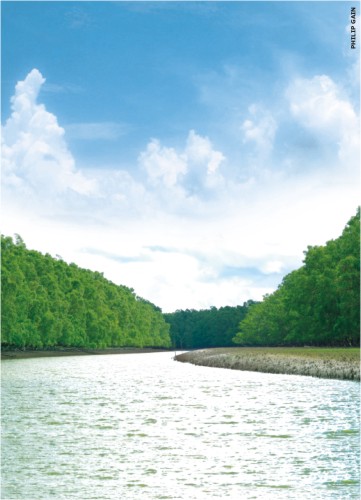 A
A

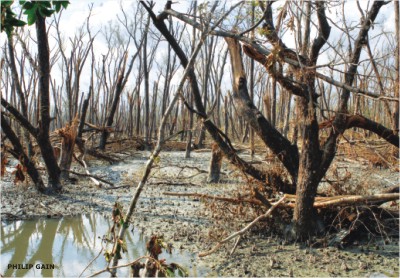 We land at Katka forest office barefoot, because the jetty has been destroyed. What we see goes beyond description. The wooden houses have no trace. The concrete houses have been piled into debris. The column of beautification trees -- jhaw, coconut, and others in front of the forest office has been broken, twisted, and blown from here to there. The forest around the office, a haven for the deer, wild pigs, and the birds, has become lifeless with twisted and broken trees.
We land at Katka forest office barefoot, because the jetty has been destroyed. What we see goes beyond description. The wooden houses have no trace. The concrete houses have been piled into debris. The column of beautification trees -- jhaw, coconut, and others in front of the forest office has been broken, twisted, and blown from here to there. The forest around the office, a haven for the deer, wild pigs, and the birds, has become lifeless with twisted and broken trees. 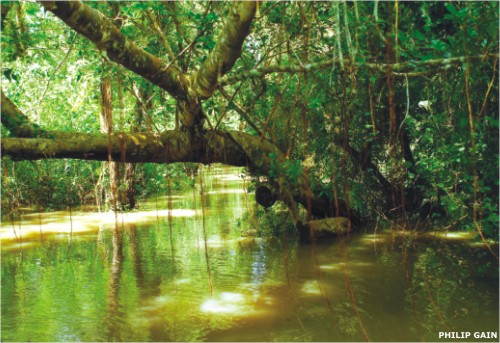
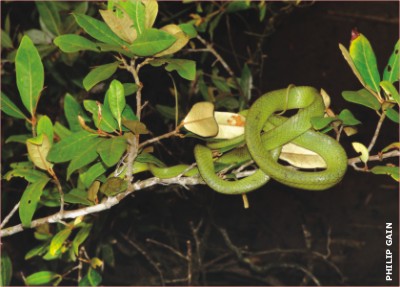 Heaven for deer and hunting ground for tiger, the lush green meadow with a carpet of sun grass and kash (thatch grass) has become miserable. We can imagine what may have happened to the wildlife in this area that merges with the bay. Darkness begins to fall and we board our launch. The full moon emerges over Dimer Char. The sea is quiet. No noise of wave. We see just one small fishing trawler on the shore. There is none in the sea. No dancing light. Our launch moves back as the night falls.
Heaven for deer and hunting ground for tiger, the lush green meadow with a carpet of sun grass and kash (thatch grass) has become miserable. We can imagine what may have happened to the wildlife in this area that merges with the bay. Darkness begins to fall and we board our launch. The full moon emerges over Dimer Char. The sea is quiet. No noise of wave. We see just one small fishing trawler on the shore. There is none in the sea. No dancing light. Our launch moves back as the night falls. 
